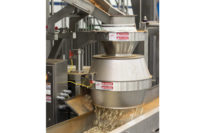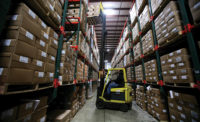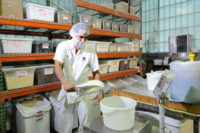Hudson Bread, North Bergen, N.J., is rather a paradox. Starting out in 1994 as a small, fully artisan bakery owned and operated by president/chief executive Mariusz (Mark) Kolodziej, Hudson Bread became a favored producer, as its scrumptious baguettes, boules, rolls, brioche, buns, Ciabattas, Pullman loaves and much more gave it plenty of momentum to grow and expand. The bakery has quickly gained the respect and praises of the tri-state area for its distinctive products, reliable customer service and sophisticated technology. An artisan baker using sophisticated equipment? Yes.
While traditional artisan techniques are as integral to Kolodziej and his current staff of 100 employees as breathing, Hudson uses highly advanced production equipment and technologies to churn out some 250 stock-keeping units (SKUs), delivering fresh breads daily. On average, the bakery produces as much as 40,000 lb. of dough a day, or up to 270,000 lb. a week. The products include different varieties of baguettes, ficelles, dinner rolls, dozens of sandwich breads, breadsticks, boules, Pullman loaves, focaccia and freeform breads. Some of the products, such as Hudson’s signature raisin walnut loaves, onion and olive pockets and petite French rolls, are still made by hand.
“Technology has brought us to new heights,” Kolodziej says. “We are equipped with the best equipment in the industry. All of our dough processes are controlled, and we have automatic ingredient handling and sophisticated ovens and retarder/proofers. The relationship we have developed with our equipment suppliers is second to none, so we couldn’t be happier with their products. Our customers understand that the art of making bread can be copied but never duplicated.”
Redefining artisan techniques
Demand has increased to a point where the bakery couldn’t afford not to automate. While artisanal bread has been defined as only being made by hand, Hudson is redefining the term. It has to; it operates seven days a week, 24 hours a day and nearly 365 days a year. It closes only on Christmas day.
“A bakery like ours would need 50 to 60 people to create artisan bread by hand,” says Ray Million, vice president of operations. “We make it now with 20 people in a more automated way. We have six production lines (one is manual) that maintain artisan baking principles, which include time, forming the dough in a certain manner, proper resting and fermentation, baking the product, and hand-manipulating product using artisan practices.”
This automated approach includes five stress-free makeup lines outfitted with shiny-clean high-tech production equipment such as computerized mixing systems, automatic macro and micro ingredients discharging/dispensing units, four stone hearth deck ovens, five rotating rack ovens, a new vacuum chamber for cooling products down to packing temperatures, a pick-to-light case-packing system, an automatic bread loading and unloading system linked with the ovens and more technology to come. The fifth stress-free makeup line was installed in mid-2011. It has a new type of divider geared for short dough runs. “The equipment’s always evolving so we try to keep up with the changes,” Million says. “Soon, we’re going to revamp some of our oven systems.”
However, several of the breads are still made by hand at the plant and some proc esses are still semi-automatic or manual. Small rolls and breads are made by hand on tables next to the production lines. And all of the mixed dough is hand-scored and adjusted by hand if need be. “We do that because it gives the product a more natural look,” says Million. “We know how to control the scoring. It’s an art. We have a balance of automation and hand crafting. This is an artisan bakery, yet we look at how we can produce more without compromising product quality,” he says.
Million is a culinary graduate with more than 25 years in the industry. He came on board in 2007. “We’re slowly phasing in a new set of equipment, and are working on learning how to operate a new vacuum chamber,” he says. “We’re going to put in another mixer by December, and we hope to add more ovens at the end of the holiday cycle. We change out our equipment every few years. We work with vendors we feel comfortable with and they suggest new things, things we should replace,” he says. “Some of these systems are three or four years old, and we’ll probably be replacing them at the end of next year. We have several projects coming up in the next month.”
Preferments and allergens
The main rooms in the plant are all climate-controlled. The five semi- and fully-automatic production lines are fed by two 60,000-lb. internal silos that hold unbleached, unbromated flour. Liquid-ingredient tanks holding 600 liters of eggs, yeast, milk and other minor ingredient bins are positioned on the automatic dispensing system on a mezzanine level overlooking the plant floor.
“This is where we store and segregate all of our allergens,” Million points out. “We keep eggs, nuts, milk and other items in this area. We have one critical control point, which is basically the allergen trail. So we make sure all allergens are segregated from production. Basically we formulate a run of the allergen-containing dough toward the end of the shift, so any product that’s allergy-related is run on a separate line and that line is broken down and washed down in a two-hour cleaning and sanitation cycle and is ready for the next day.”
The ingredients dispense automatically into the 450-lb.-capacity bowls of three twin-axis mixers on the main plant floor level. The mezzanine area also includes large tanks holding 3,000- and 1,500 liters of natural sours and poolish.
“We have 18 mother dough recipes that we store in this system,” Million explains.
“We also want to maintain a light, natural full-flavor dough, so went with stress-free makeup equipment,” Million says. “The five stress-free lines handle the dough very gently, with the least amount of mechanical stress as possible. There’s no impact to the dough structure.”
The liquid poolish usually comprises 120- to 140% hydration, Million adds. “It usually takes 12 to 16 hours to mature. Our computer-controlled metering of flour, water and other ingredients facilitates production, which is done the day before the doughs are baked. The tanks have three feeding stages throughout the night,” he says. Water and flour can be added to the preferment tank, which is equipped with a turning mix attachment. The temperature within the tanks also rises through the night automatically to about 80°F as the starter reaches the point where it’s ready, and then the tanks cool it down automatically to 50°F, he says.
“All of our breads use a preferment of some sort,” he continues. “It may be a natural sour with a very tight hydration—usually 60-70%—or it might be something else.” One strong whiff of the contents of one tank smelled similar to beer. “This is naturally yeasted, so it helps to flavor the dough. We see many positive results using liquid sours,” he says. “They help increase the shelf life of our products because a mature dough has a better shelf life than a straight-run dough.”
Million says the preservative- and chemical-free breads also contain no mold inhibitors. “Everything is natural,” Million notes. “We use the best ingredients and bake fresh daily. The breads generally have a one-day shelf life, but they’re really fine for as many as three days.”
Mixing, dividing, moulding
Water chillers control the water temperature in the dispensing system. Malt, sugar, salt, poppy seeds, sunflower seeds and other assorted ingredients that are included in product profiles are also distributed automatically to the mixers from a scale hopper discharge chute. The scale hoppers weigh each recipe and discharge the metered mix through the chutes, down over a discharge hood and into the mixing bowl. The dough mixture can sit anywhere between an hour to two hours in the bowl to ferment before it’s brought up to the makeup lines.
On the day of Snack Food & Wholesale Bakery’s visit, the lines were running assorted items, including French baguettes. “We’ll run anywhere from 3,000 to 4,000 baguettes a day,” Million says. The products range in size from a 2-oz. dinner roll to a 10-lb. country boule.
“We can run the lines faster, but find things work well at speeds of 1,000 an hour, which gives us a nice interior structure, and a nice, thin crust,” he says.
After the dough is mixed, the mixing bowl is hoisted automatically to a dough trough incorporating two star cutting wheels that cut a ribbon of dough 12 in. wide. The dough then falls into a feeding belt that reduces and gently smoothes out the ribbon to the thickness required using a delicate motion so as not to damage the dough in any way. The dough then passes through a station that manipulates it, presses it out, just as human hands would, and continues to smooth it into a sheet. Next, the sheet is trimmed and the dough pieces are scaled and guillotined into specific shapes.
The dough next passes through a section where it’s shaped further or is sheeted, stretched and curled by roller belts running in opposite directions. The dough is folded down, folded up and folded down again and then is elongated. One belt moves forward and one moves backward to simulate the hand pressure of elongating the baguette.
The dough ribbon then progresses to a rolling conveyor that acts as a resting board. Then, it’s ready for an aligner, if necessary, and the pieces pass over a retracting belt, and onto a semolina- or cornmeal-dusted peel board.
Just relax
The dough can also be topped with seeds by an applicator, depending on the product and customer request. As the dough pieces work their way to the end of the line, an operator stretches them a bit, adjusts the corner tips and loads four of the dough baguettes onto a peel board and then onto a rack, which is brought to the oven area. The products have a slightly inconsistent look—and that’s the way it should be, Million explains. “We don’t want it to look 100% perfect so that it has that artisan touch.”
To one side of the main production floor is a racking room where breads and rolls sit in racks to relax. Another area houses the oven room, where the large automatic loader/unloader is used. But the racks of baguette dough are brought to a rack proofer with 256 pockets where it sits for (in this case) 20 minutes at 76°F and 30-40% relative humidity (RH), where it can rest. The racks can also be brought over to a spacious, computerized 700-rack retarder room where the dough can develop and mature from eight to 24 hours, depending on the product, to bring out its flavor, crust, crumb and tenderness. The retarder room is set at cooler temperatures of 44- to 46°F.
“We let our doughs relax,” Million says. “Doing things slowly and coolly means we don’t have to worry about overproofing, which can leave a product with no taste, in our opinion. Our major push is retarding our doughs. The objective is to create an environment of working a day ahead. What we make today, is really for tomorrow. I have tonight’s bake all ready to go. If there are any changes midstream, we have 24 hours to make adjustments.”
The makeup lines are changed over from product to product, depending on customer requirements, volume and quantity. “We have several changeovers of the lines throughout the day,” Million says. “They run mother doughs that range in weight up to 40,000 lb. We can change over eight or nine times in the course of a production run. There are a lot of short runs, but the changeovers aren’t that complicated—they’re a matter of switching some belt configurations and adjusting a couple of height and tension knobs and adjusting speeds. But that’s programmable, so we just press a few buttons.”
Plant personnel hand score all of the products. “We hand score everything,” Million adds. “We do that because it gives the products a more natural look, and we can control the scoring. It’s an art. We are working with a live piece of dough, so there are variations in each piece.”
When the dough is ready, the racks are brought out and moved to the oven room, which is heated at about 82°F. The dough pieces are placed on the loader/unloader leading to the ovens. There, depending on the product, the dough can be baked on four stone hearth deck ovens that hold 12 pans each or on five rotating rack ovens that bake on screens. Also depending on the product, baking temperatures range from 450-480°F. One-lb. breads bake for 30 minutes at 480°F while baguettes bake for 20 minutes at 475°F and 2- and 3-lb. loaves bake at 480°F for one hour, 10 minutes.
After baking, the pans of bread are removed from the conveyorized loader/unloader, and are placed on cooling racks. Currently, the racks are left to cool for anywhere from 1.5 to 2.5 hours, depending on the temperatures outside. But the new vacuum chamber will considerably reduce that amount of time, he points out. “We wanted something that would give us more cooling time consistency year-round and wouldn’t dry out the bread,” he says. “This will be done to free up our racks, keep the right product consistency and cool things more quickly, so that we don’t lose any shelf life, and so that we offer a fresher product.”
Picking, packing, shipping
Operators then transfer the racks of cooled breads and rolls to the packaging groom, where a pick-to-light system is used to fill orders. The paperless dispatching system houses data to assemble, pack and ship each order, conveniently presenting the information on LED (light emitting diode) displays installed above the picking stations.
When ready, the order is closed out, the breads are case-packed in custom bag-lined corrugated cases printed with the Hudson Bread logo and are placed in a central location. Loads are palletized manually and are later put into a waiting truck.
Easy does it
A bread slicing/cooling room incorporates three slicers and twist-tying machines for small breads and the Pullman loaves. Operators semi-automatically slice and bag the breads in clear film bags printed in gold with the Hudson logo and illustrations of wheat.
Million says that like the stress-free lines, Hudson wants its people on the production floor to be relaxed, without stress either. “We want them to work happy, to like their job and enjoy what they do. Because they’re making beautiful bread.”
Rushing around and moving too fast can translates into the dough being made, he summarizes. “If we work relaxed and easy, we make a nicer product. If we’re behind the 8 ball, the product could resemble that. We like everyone to be relaxed. We work better that way.” It shows. The wonderful breads are proof positive that Hudson’s methods work.










